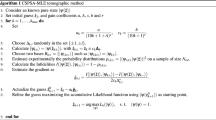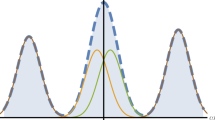Abstract
It is important to be able to determine the state of a quantum system and to measure properties of its evolution. State determination can be achieved using tomography1, in which the system is subjected to a series of experiments, whereas spectroscopy can be used to probe the energy spectrum associated with the system's evolution. Here we show that, for a quantum system whose state or evolution can be modelled on a quantum computer, tomography and spectroscopy can be interpreted as dual forms of quantum computation2. Specifically, we find that the phase estimation algorithm3 (which underlies a quantum computer's ability to perform efficient simulations4 and to factorize large numbers5) can be adapted for tomography or spectroscopy. This is analogous to the situation encountered in scattering experiments, in which it is possible to obtain information about both the state of the scatterer and its interactions. We provide an experimental demonstration of the tomographic application by performing a measurement of the Wigner function (a phase space distribution) of a quantum system. For this purpose, we use three qubits formed from spin-1/2 nuclei in a quantum computation involving liquid-state nuclear magnetic resonance.
This is a preview of subscription content, access via your institution
Access options
Subscribe to this journal
Receive 51 print issues and online access
$199.00 per year
only $3.90 per issue
Buy this article
- Purchase on Springer Link
- Instant access to full article PDF
Prices may be subject to local taxes which are calculated during checkout



Similar content being viewed by others
References
Smithey, D. T., Beck, M., Reymer, M. G. & Farydani, A. Measurement of the Wigner distribution and the density matrix of a light mode using optical homodyne tomography: Application to squeezed states and the vacuum. Phys. Rev. Lett. 70, 1244–1247 (1993)
Nielsen, M. & Chuang, I. Quantum Information and Computation (Cambridge Univ. Press, Cambridge, 2000)
Kitaev, A. Yu. Quantum measurements and the Abelian stabilizer problem. Preprint quant-ph/9511026 at 〈http://xxx.lanl.gov〉 (1995).
Lloyd, S. Universal quantum simulators. Science 273, 1073–1078 (1996)
Shor, P. W. Polynomial-time algorithms for prime factorization and discrete logarithms on a quantum computer. SIAM J. Comput. Sci. 26, 1484–1509 (1997)
Cleve, R., Ekert, A., Macchiavello, C. & Mosca, M. Quantum algorithms revisited. Proc. R. Soc. Lond. A 454, 339–354 (1998)
Barenco, A. et al. Elementary gates for quantum computation. Phys. Rev. A 52, 3457–3467 (1995)
Feynman, R. P. Simulating physics with computers. Int. J. Theor. Phys. 21, 467–488 (1962)
Abraham, D. & Lloyd, S. Quantum algorithm providing exponential speed increase for finding eigenvalues and eigenvectors. Phys. Rev. Lett. 83, 5162–5165 (1999)
Knill, E. & Laflamme, R. Power of one bit of quantum information. Phys. Rev. Lett. 81, 5672–5675 (1999)
Hillery, M., O'Connell, R. F., Scully, M. O. & Wigner, E. P. Distribution functions in physics: fundamentals. Phys. Rep. 106, 121–167 (1984)
Paz, J. P. & Zurek, W. H. in Coherent Matter Waves, Les Houches Session LXXII (eds Kaiser, R., Westbrook, C. & David, F.) 533–614 (EDP Sciences, Springer, Berlin, 2001)
Wootters, W. K. A Wigner function formulation for finite state quantum mechanics. Ann. Phys. NY 176, 1–21 (1987)
Leonhardt, U. Discrete Wigner function and quantum-state tomography. Phys. Rev. A 53, 2998–3013 (1996)
Miquel, C., Paz, J. P. & Saraceno, M. Quantum computers in phase space. Phys. Rev. A (in the press); preprint quant-ph/0204149 at 〈http://xxx.lanl.gov〉 (2002)
Miquel, C., Paz, J. P. & Perazzo, R. Factoring in a dissipative quantum computer. Phys. Rev. A 54, 2605–2613 (1996)
Zurek, W. H. Sub-Planck structure in phase space and its relevance for quantum decoherence. Nature 412, 712–717 (2001)
Cory, D. G. et al. Experimental quantum error correction. Phys. Rev. Lett. 81, 2152–2155 (1998)
Knill, E., Chuang, I. & Laflamme, R. Effective pure states for bulk quantum computation. Phys. Rev. A 57, 3348–3363 (1998)
Lutterbach, L. G. & Davidovich, L. Method for direct measurement of the Wigner function in cavity QED and ion traps. Phys. Rev. Lett. 78, 2547–2550 (1997)
Lvovsky, L. et al. Quantum state reconstruction of the single-photon Fock state. Phys. Rev. Lett. 87, 402–405 (2001)
Nogues, G. et al. Measurement of a negative value for the Wigner function of radiation. Phys. Rev. A 62, 4101–4104 (2000)
Acknowledgements
This work was supported by UBACYT, ANPCYT, Fundación Autorchas (J.P.P., C.M. and M.S.) and NSA (E.K., R.L. and C.N.).
Author information
Authors and Affiliations
Corresponding author
Ethics declarations
Competing interests
The authors declare that they have no competing financial interests.
Rights and permissions
About this article
Cite this article
Miquel, C., Paz, J., Saraceno, M. et al. Interpretation of tomography and spectroscopy as dual forms of quantum computation. Nature 418, 59–62 (2002). https://doi.org/10.1038/nature00801
Received:
Accepted:
Issue Date:
DOI: https://doi.org/10.1038/nature00801
This article is cited by
-
Hardware-efficient quantum principal component analysis for medical image recognition
Frontiers of Physics (2024)
-
NISQ computing: where are we and where do we go?
AAPPS Bulletin (2022)
-
Quantum state tomography of molecules by ultrafast diffraction
Nature Communications (2021)
-
Trends in Quantum Optics
Resonance (2020)
-
Optical experiment to test negative probability in context of quantum-measurement selection
Scientific Reports (2019)
Comments
By submitting a comment you agree to abide by our Terms and Community Guidelines. If you find something abusive or that does not comply with our terms or guidelines please flag it as inappropriate.



